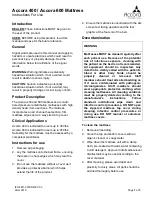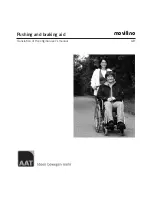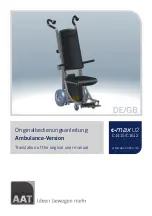
930476 Rev. E
10
P-222
VI. GENERAL WARNINGS
At A Minimum:
1. Open sides of ramp must have side rails to prevent your
chair from going over the edge.
2. Slope must not be steeper than one inch in height for every
one foot of slope length (approximately 5º).
3. Ramp surface must be even, and have a non-skid surface.
4. You may need to add a section at the top or bottom to avoid
a lip or drop-off.
5. Ramp must be sturdy. Add bracing if needed, so ramp does
not “bow” when you ride on it.
V. WHEELCHAIR LIFTS
WARNING
Wheelchair lifts are used in vans, buses, and buildings to
help you move from one level to another.
1. Always turn
off
all power to your chair when you are on a
lift. If you fail to do so, you may touch the joystick by acci-
dent and cause your chair to drive off the platform. (Be
aware that a “roll-stop” at the end of the platform may not
prevent this).
2. Make sure there is not a lip or drop-off at the top or bottom
of the platform. These may cause a fall or tip-over. When in
doubt, have someone help you.
3. Always position the rider securely in the chair to help prevent
falls while on a lift.
4. Avoid moving forward if a wheel is “hung up” on the lip of
the ramp. Backup, reposition the caster for a more direct
approach. And slowly try again.
W. CURBS & SINGLE STEPS
WARNING
1. Your chair is not designed to drive up or down a curb or step
more than two (2) inches (5 cm) high. Doing so may:
•
Result in a fall or tip-over.
•
Damage the frame, wheels, axles or other chair parts, or
loosen fasteners.
2. To prevent a fall or tip-over, use wheelchair access ramps or
have someone help you.
3. If you must climb or descend a curb or step alone do so at
your own risk and use extreme care.
•
Go as straight up or straight down as you can.
Never
turn
or climb or descend at an angle as a fall or tip-over is likely.
•
Proceed slowly, at a steady speed.
4. Make sure that persons who assist you review the “Tips For
Attendants” and heed all warnings.
X.STAIRS
WARNING
Never use this chair to go up or down stairs, even with
an attendant. Doing so is likely to cause a fall or tip-over.
Y. ESCALATORS
WARNING
Never take this chair on an escalator, even with an
attendant. Doing so is likely to cause a fall or tip-over.
S. RAMPS, SLOPES & SIDEHILLS
WARNING
The center of balance of your chair changes when you
are on a slope.
NOTE–
“Slope” includes a ramp or sidehill. Your chair is less stable when it
is at an angle. Never use this chair on a slope unless your are sure
it is safe. When in doubt, have someone help you.
Beware Of:
1. Steep slopes. Do NOT use this chair on a slope steeper than
10°.
2. Wet or slippery surfaces (such as when ice, snow, water or oil
film is present). A loss of traction may cause a fall or tip-over.
3. A change in grade on a slope (or a lip, bump or depression).
These may cause a fall or tip-over.
4. A drop-off at the bottom of a slope. (A drop-off of as small
as 3/4 inch (12 mm) can stop a front caster and cause the
chair to tip forward).
T. TO REDUCE THE RISK OF A FALL,
TIP-OVER OR LOSS OF CONTROL:
WARNING
1. Never use your chair on a slope unless you are sure you can
do so without losing traction.
2. Always go as straight up and as straight down as you can.
•
Do not “cut the corner” on a slope or ramp.
•
Do not turn or change direction on a slope.
3. Always stay in the center of the ramp. Make sure ramp is
wide enough that you are not at risk that a wheel may roll off
the side.
4. Lean or press your body uphill.
This will help adjust for a
change in the center of balance
caused by the slope. (Fig. 1)
5. Keep your chair moving at a
slow, steady speed. Keep con-
trol over the chair at all times.
•
On a descent, do not let
your chair accelerate
beyond its normal speed.
•
If the chair picks up speed, center the joystick to slow
down or stop.
NOTE–
The solid state controller of your chair has a logic system that will
help control your speed when driving on a slope or uphill.
•
If you stop, re-start slowly.
6. Never use rear wheel locks to try to slow or stop your chair.
This is likely to cause the chair to veer out of control.
U.RAMPS AT HOME & WORK
WARNING
Make sure ramps meet all Building Codes for your area.
1. For your safety, have a licensed contractor build or remodel
ramp to meet all standards.
2.
NOTE–
The proper design will vary, depending on such
things as: the length and height of the ramp; the need for an
intermediate platform; landing size; doors, and the direction
of swing, and; whether the ramp includes a turn or angle.
1











































